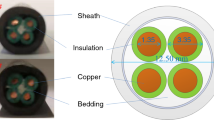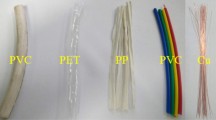Abstract
The toxicity of combustion product gas of CR/EPR cables, which are widely used in nuclear power plants, has been investigated according to the aging period. The cable specimens were prepared by thermal acceleration aging method, from non-aged to 40-year-old cables at spans of 10 years. The cable sheath and insulation materials were tested separately. The test was conducted in accordance with the Naval Engineering Standard 713 standard code, which measures the amount of 13 exhaust toxic gases when 1 gram of the test specimen is burnt. The toxicity index and the amount of emission gases were varied irregularly with respect to the aging period, and the reason for this result could not be clearly explained due to the lack of information on cable material. However, the reason could be qualitatively estimated to have two conflicting effects: (1) Reduced flame retardant performance as the devolatilization process proceeded over time, and (2) the enhanced stabilization of double bonds between carbon compounds and flame retardant elements, such as chlorine or bromine, as the cable is aged. The toxicity of the accelerated aging period of 20 years was much higher than that of non-aged cables, which signifies increased probability of fire risks of aged cables from the viewpoint of toxicity. Furthermore, when comparing the adjusted toxicity index calculated without CO, CO2, and NOx emission, it can be clearly determined that the average toxicity index of aged cables is higher than that of non-aged cables. Thus, in conclusion, human hazardousness of a cable fire increases from the viewpoint of toxicity of emission gases as it deteriorates, so safety regulations or maintenance guides for old nuclear power plants should be reinforced considering this toxicity variation. The results obtained from this study can be used to improve the reliability of operator manual actions for safety-shutdown and fire-suppression activities and to provide basic information for studies on fire suppression.
Similar content being viewed by others
Abbreviations
- q :
-
Temperature rise rate (oC/min)
- T p :
-
Peak point temperature (oC)
- E α :
-
Activation energy (kcal/mol)
- R:
-
Gas constant expressed as 8.314 J·mol−1·K−1
- C i :
-
Corrected concentration of gas (ppm)
- m :
-
Test specimen mass (g)
- V :
-
Volume of the test chamber (m3).
- C e :
-
Concentration of the detected harmful components in the detected gas products
- C f :
-
Fatal concentration to people after 30 minutes of expo sure (ppm)
- CR:
-
Poly-chloroprene rubber
- EPR:
-
Ethylene propylene rubber
- TG:
-
Thermogravimetry
References
NUREG-0050 U.S. Nuclear Regulatory Commission, Recommendation Related to Browns Ferry Fire, Report by Special Review Group, Washington D.C. (1976).
T. Sakurahara, Z. Mohaghegh, S. Reihani, E. Kee, M. Brandyberry and S. Rodgers, An integrated methodology for spatiotemporal incorporation of underlying failure mechanisms into fire probabilistic risk assessment of nuclear power plants, Reliability Engineering & System Safety, 169 (2018) 242–257.
H. J. Seo, N. K. Kim, J. M. Jo, M. C. Lee, S. K. Lee and Y. S. Moon, A study on the human toxicity of combustion products for non class 1E cables, J. of Korean Society of Hazard Mitigation, 18 (2) (2018) 215–222.
H. S. Lim and D. H. Kim, A study on heat-flux evaluation for cable fire including diagnostic methodology for degradation in nuclear power plants, J. of The Korean Society of Safety, 26 (2) (2011) 20–25.
D. I. Kang, K. Y. Kim and S. C. Jang, Risk assessment on the fire-induced spurious operations of high pressure safety injection system for domestic nuclear, Proceeding Fall Conference Kor. Institute of Fire Sci. & Eng. (2012) 303–306.
N. Alvares and A. C. Fernandez-Pello, Fire initiation and spread in overloaded communication system cable trays, Experimental Thermal and Fluid Science, 21 (2000) 51–57.
Y. Zhao, W. Xi and P. Jijun, Theoretical and experimental investigation on the flame-retarding characteristic of R245fa, Experimental Thermal and Fluid Science, 44 (2013) 613–619.
T. R. Hull, A. A. Stec, K. Lebek and D. Price, Factors affecting the combustion toxicity of polymeric materials, Polymer Degradation and Stability, 92 (12) (2007) 2239–2246.
H. J. Seo, N. K. Kim, J. M. Jo and M. C. Lee, Fire properties of pinus densiflora utilizing fire-retardant chemicals based on borate and phosphorus (II) - Thermal and gas emission characteristics, Bioresources, 13 (1) (2018) 506–521.
W. A. Al-Sayegh, O. Aljumaiah, G. E. Andrews and H. N. Phylaktou, PVC cable fire toxicity using the cone calorimeter, 10th Asia-Oceania Symposium on Fire Science and Technology, Tsukuba, Japan (2015) 175–182.
L. Yang, J. Li, D. Zhao, W. Fang and W. Fan, A microcosmic discrete occupant evacuation model based on individual characteristics, Science in China Ser. E Engineering & Materials Science, 47 (5) (2004) 608–615.
Y. Y. Chu, H. Zhang, S. F. Shen, R. Yang and L. F. Qiao, Development of a model to generate a risk map in a building fire, Science China Technological Sciences, 53 (10) (2010) 2739–2747.
A. Sojoudi, H. Afshin and B. Farhanieh, An analysis of carbon monoxide distribution in large tunnel fires, J. of Mechanical Science and Technology, 28 (5) (2014) 1917–1925.
S. K. Lee, Y. S. Moon and S. Y. Yoo, A study on validation methodology of fire retardant performance for cables in nuclear power plants, J. of the Korean Society of Safety, 32 (1) (2017) 140–144.
B. Feng, Z. Yang and R. Zhai, Experimental study on the influence of the flame retardants on the flammability of R1234yf, Energy, 143 (2018) 212–218.
A. Witkowski, B. Girardin, M. Forsth, F. Hewitt, G. Fontaine, S. Duquesne, S. Bourbigot and T. R. Hull, Development of an anaerobic pyrolysis model for fire retardant cable sheathing materials, Polymer Degradation and Stability, 113 (2015) 208–217.
T. Sakurahara, Z. Mohaghegh, S. Reihani, E. Kee, M. Brandyberry and S. Rodgers, An integrated methodology for spatio-temporal incorporation of underlying failure mechanisms into fire probabilistic risk assessment of nuclear power plants, Reliability Engineering and System Safety, 169 (2018) 242–257.
NES 713, Determination of the Toxicity Index of the Products of Combustion from Small Specimens of Materials, Ministry of Defense Naval Engineering Standards, London, U.K. (1990).
Y. Liu, Z. Jiang, D. Wang and X. Li, Experimental research on the water mist fire suppression performance in an enclosed space by changing the characteristics of nozzles, Experimental Thermal and Fluid Science, 52 (2014) 174–181.
Y. S. Cho, M. J. Shim and S. W. Kim, Thermal degradation kinetics of PE the Kissinger equation, Materials Chemistry and Physics, 52 (1) (1998) 94–97.
S. Farag and J. Chaouki, A modified microwave thermosgravimetric- analyzer for kinetic purposes, Applied Thermal Engineering, 75 (2015) 65–72.
ASTM D 470-82, Standard Test Method for Crosslinked Insulations and Jackets for Wire and Cable, Annual Book, ASTM Standards (2009).
H. Kissinger, Variation of peak temperature with heating rate in differential thermal analysis, J. of Research of the National Bureau of Standards, 57 (4) (1956) 217–221.
International Organization for Standardization, ISO 19702: 2015, Guidance for Sampling and Analysis of Toxic Gases and Vapors in Fire Effluents using Fourier Transform Infrared (FTIR) Spectroscopy, Geneva (2015).
Y. Choi, I. Joe, S. Lee and K. Oh, An experimental study on the ignition and emissions characteristics of wallpapers, J. of Mechanical Science and Technology, 23 (2009) 2839–2847.
K. Jayaraman, M. V. Kok and I. Gokalp, Pyrolysis, combustion and gasification studies of different sized coal particles using TGA-MS, Applied Thermal Engineering, 125 (2017) 1446–1455.
C. K. Park, D. I. Kang, C. S. Ha, J. K. Lee and W. J. Cho, Properties of blends containing polychloroprene or poly(vinylchloride) with AES, Polymer (Korea), 16 (4) (1992) 305–311.
R. B. Nageshwar, R. Arunjothi and A. R. Srinivasan, Evaluation of fire gases from polymeric materials, 2012 IEEE 10th International Conference on the Properties and Applications of Dielectric Materials, Bangalore, India (2012).
Y. I. Mok, A review of the flame retardation of flammable polymers, Korean Chemical Engineering Resources, 15 (4) (1977) 211–224.
H. J. Seo, S. G. Jeong and S. Kim, Development of thermally enhanced wood-based materials with high VOCs adsorption using exfoliated graphite nanoplatelets for use as building materials, Bioresources, 10 (4) (2015) 7081–7091.
D. H. Lee, H. J. Choi, D. S. Kim and B. H. Lee, Distribution characteristics of pyrolysis products of polyethylene, Polymer (Korea), 32 (2) (2008) 157–162.
H. J. Seo and D. W. Son, Hazard assessment of combustion gases from interior materials, J. of Korean Fire Science and Engineering, 29 (4) (2015) 49–56.
Stability and Stabilization of Polymers under Irradiation, IAEATECDOC- 1062, IAEA (1999).
C. S. Chou, S. H. Lin, C. I. Wang and K. H. Liu, A hybrid intumescent fire retardant coating from cake- and eggshell-type IFRC, Powder Technology, 198 (2010) 149–156.
S. K. Song, A study on the combustion characteristics according to the aging of communication cables and power cables, Ph.D. Thesis, Department of Fire & Emergency Management, Graduate School of Industry & Science, Kangwon National University, Kangwon, Republic of Korea (2011).
S. Bae, J. Choi, C. Kim, W. Hong and H. S. Ryou, Development of new evacuation model (BR-radiation model) through an experiment, J. of Mechanical Science and Technology, 30 (7) (2016) 3379–3391.
Acknowledgments
This work was supported by the Nuclear Safety Research Program through the Korea Foundation of Nuclear Safety (Ko-FONS) using the financial resources granted by the Nuclear Safety and Security Commission (NSSC) of the Republic of Korea (No. 1705002).
Author information
Authors and Affiliations
Corresponding author
Additional information
Recommended by Editor Yong Tae Kang
Min Chul Lee received his M.S. in Mechanical Engineering from Korea Advanced Institute of Science and Technology, Korea, in 2003 and a Ph.D. in Mechanical and Aeronautical Engineering from Seoul National University in 2014. Currently, he is a Professor at Incheon National University and Head of the Combustion and Fire Engineering Laboratory. He has worked on a number of joint government and industry projects to develop next-generation, low-emission, fuel-flexible gas turbine combustor and fire safety technology.
Hyun Jeong Seo received her M.S. in Architecture Engineering from Soongsil University, Korea, in 2015. Currently, she is a Ph.D. candidate at Incheon National University. Her research topic is combus-tion and fire safety engineering.
Nam Kyun Kim received his Ph.D. in Safety Engineering from Incheon National University in Incheon, Korea, in 2014. Currently, he is a Professor at Suncheon Jeil College. He has worked in the fire protection sector and has been involved in numerous national projects. He has studied the inhalation toxicity of combustion products (particulate matter, gas).
Young Seob Moon received his B.S. in Bio-Chemical Engineering from Korea University, Korea, in 2007. Now, he is a researcher at KINS (Korea Institute of Nuclear Safety). He has been an R&D project researcher related to fire protection in the nuclear field.
Sang Kyul Lee received his M.S. in Mechanical Engineering from Kookmin University, Korea, in 1997. Currently, he is a Principal Researcher at KINS (Korea Institute of Nuclear Safety). He has been R&D project manager related to fire protection in the nuclear field.
Rights and permissions
About this article
Cite this article
Seo, H.J., Kim, N.K., Lee, M.C. et al. Investigation into the toxicity of combustion products for CR/EPR cables based on aging period. J Mech Sci Technol 34, 1785–1794 (2020). https://doi.org/10.1007/s12206-020-0340-z
Received:
Revised:
Accepted:
Published:
Issue Date:
DOI: https://doi.org/10.1007/s12206-020-0340-z




